A very nice 3D puzzle you have put together. Not so easy!
You are using an out of date browser. It may not display this or other websites correctly.
You should upgrade or use an alternative browser.
You should upgrade or use an alternative browser.
"Flying Cloud " by Mamoli - kit bash
- Thread starter Peter Gutterman
- Start date
- Watchers 15
- Joined
- Jun 17, 2021
- Messages
- 1,670
- Points
- 488

Thanks, Paul. I believe you replied before I was even done editing! Yes, 3D puzzle is exactly right. I assemble and disassembled it in my head countless times before doing anything irreversible, which dogs every step! 
I like your nibling planks, the deck nicely looking!
- Joined
- Jun 17, 2021
- Messages
- 1,670
- Points
- 488

Thanks, Jim and thanks for following! 
DittoI like your nibling planks, the deck nicely looking!
- Joined
- Jun 17, 2021
- Messages
- 1,670
- Points
- 488

On to the taffrail which doubles for the pin rail for the mizzen mast. I cut the rail out of the same left-over piece of mahogany plywood veneer I had used for the monkey rails, which facilitated cutting the rail from a single piece. I marked the centerline for the taffrail with a compass set to the proper width from the edge of the rail to the center and marked the drill points for the stanchion pins. I tack glued it onto the matching railing below it with stick school glue (very light tack, easy to release) and a bit of low tack masking tape. I transferred the drilling points for the holes for the stanchion post pins with an awl, then drilled them through, being careful to mark the drilling depth on the drill with a bit of tape. I lightly sanded the taffrail, both sides, stained it with a stain marker and finished with amber shellac, padded on. I painted the stanchions (1/4" or 2 scale feet, white metal from BlueJacket Ship Crafters) white. I first glued the stanchions to the underside of the taffrail using Aileen's fast grab tacky glue. When dry I glued the stanchions to the monkey rail. Starting at the back, I worked my way forward and right and left simultaneously. Each time I fit a pin into its hole I fixed it with a drop of thin superglue. The stanchion castings come with a short pin on one end and a long pin on the other. The long pins I fit through the taff, or upper, rail so that the short pins would easily fit into the shallow holes in the monkey rail. This also made it easy to adjust them as I fit each in place. I nipped off the excess length of pins topside with a flat cut side-cutter and lightly sanded the surface, then touched up the finish. I show the belaying pins dry fitted into place. I am using the belaying and sail plans for the Model Shipways "Flying Fish" which was very nearly a sister ship to the "Flying Cloud", built only a couple of years apart by Donald McKay. The only major difference in the sail plans being that the " Flying Fish" had Spencer sails on the fore and main while the " Flying Cloud" did not. The other "Flying Cloud" plans I have show a more simplified sail and belaying arrangement. Yes, there are a LOT of belaying pins! I am using brass aftermarket pins. The wood pins supplied in the kit are too thick and too short. I will just let the brass patinate naturally to a dull dark brown over time. I probably left some things out, but You can fill in the blanks or ask me. 
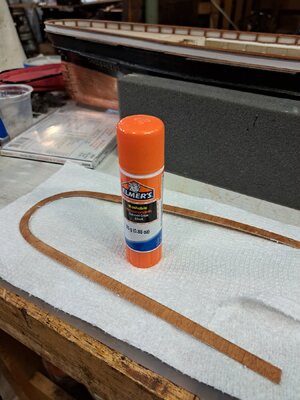
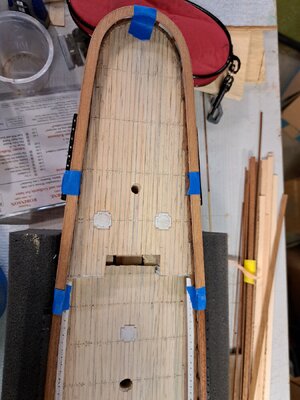
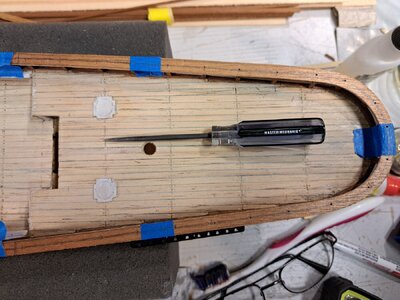
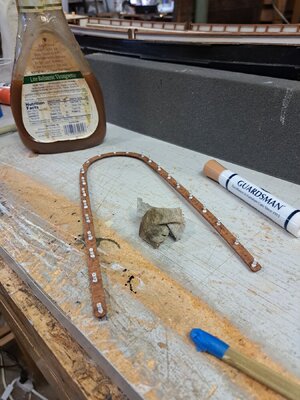
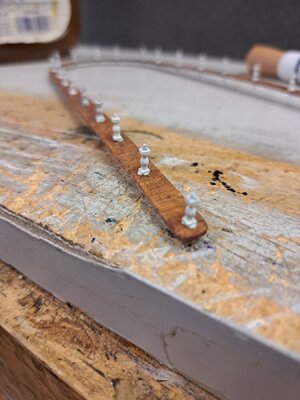
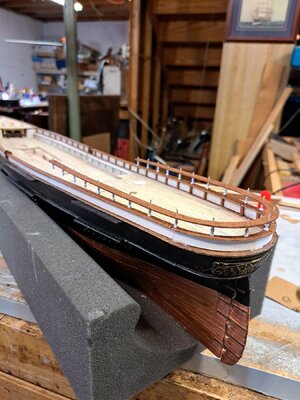
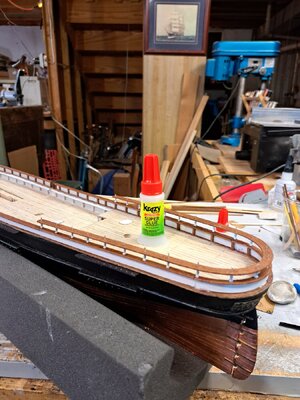
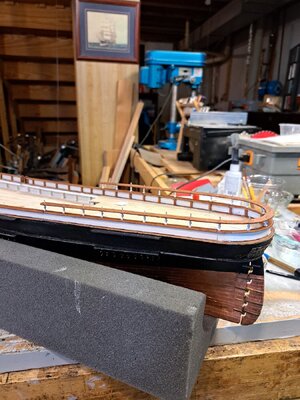
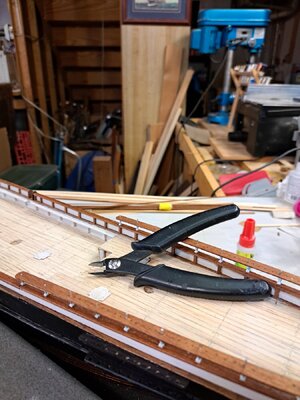
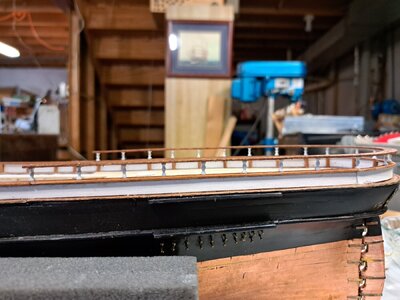
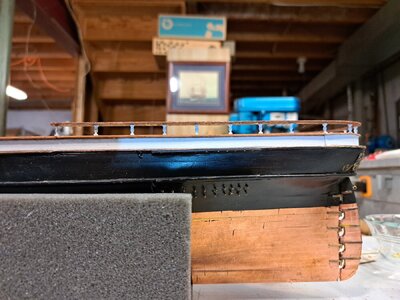
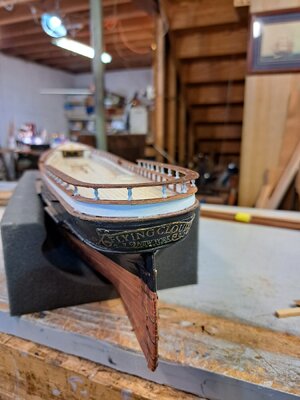
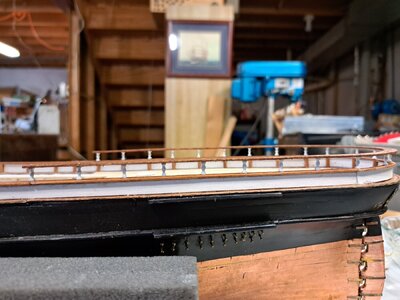
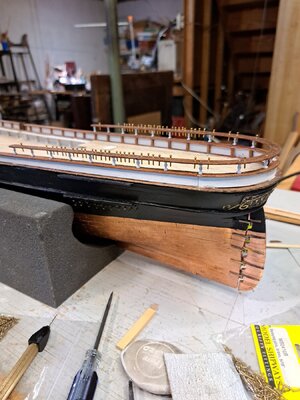
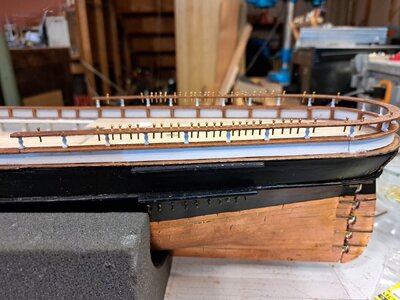















Last edited:
- Joined
- May 25, 2020
- Messages
- 372
- Points
- 228

Awesome! She's really coming together, Pete! When you say you've got momentum you really mean it!On to the taffrail which doubles for the pin rail for the mizzen mast. I cut the rail out of the same left-over piece of mahogany plywood veneer I had used for the monkey rails, which facilitated cutting the rail from a single piece. I marked the centerline for the taffrail with a compass set to the proper width from the edge of the rail to the center and marked the drill points for the stanchion pins. I tack glued it onto the matching railing below it with stick school glue (very light tack, easy to release) and a bit of low tack masking tape. I transferred the drilling points for the holes for the stanchion post pins with an awl, then drilled them through, being careful to mark the drilling depth on the drill with a bit of tape. I lightly sanded the taffrail, both sides, stained it with a stain marker and finished with amber shellac, padded on. I painted the stanchions (1/4" or 2 scale feet, white metal from BlueJacket Ship Crafters) white. I first glued the stanchions to the underside of the taffrail using Aileen's fast grab tacky glue. When dry I glued the stanchions to the monkey rail. Starting at the back, I worked my way forward and right and left simultaneously. Each time I fit a pin into its hole I fixed it with a drop of thin superglue. The stanchion castings come with a short pin on one end and a long pin on the other. The long pins I fit through the taff, or upper, rail so that the short pins would easily fit into the shallow holes in the monkey rail. This also made it easy to adjust them as I fit each in place. I nipped off the excess length of pins topside with a flat cut side-cutter and lightly sanded the surface, then touched up the finish. I show the belaying pins dry fitted into place. I am using the belaying and sail plans for the Model Shipways "Flying Fish" which was very nearly a sister ship to the "Flying Cloud", built only a couple of years apart by Donald McKay. The only major difference in the sail plans being that the " Flying Fish" had Spencer sails on the fore and main while the " Flying Cloud" did not. The other "Flying Cloud" plans I have show a more simplified sail and belaying arrangement. Yes, there are a LOT of belaying pins! I am using brass aftermarket pins. The wood pins supplied in the kit are too thick and too short. I will just let the brass patinate naturally to a dull dark brown over time. I probably left some things out, but You can fill in the blanks or ask me.View attachment 446121View attachment 446122View attachment 446123View attachment 446124View attachment 446125View attachment 446126View attachment 446127View attachment 446128View attachment 446129View attachment 446130View attachment 446131View attachment 446132View attachment 446133View attachment 446134View attachment 446135
- Joined
- Jun 17, 2021
- Messages
- 1,670
- Points
- 488

Thanks, Chuck. 
I'll have a whole new series of progressions by the end of the week!

I'll have a whole new series of progressions by the end of the week!

